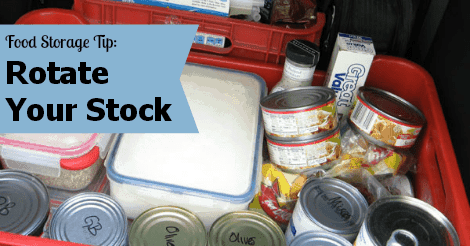When you bring a bunch of fresh provisions on the boat, where do you put them? Do you just open the lockers, find an empty spot, and stuff them in OR do you “rotate your stock?”
Years ago, working in a WaWa (sort of like a 7-11), “rotate your stock” was prominently stamped on many of the cartons that I’d have to empty onto the shelves. And it was on the sign over the time clock and again on the inside of the rest room door. It obviously made an impression on me.
Basically, rotating your stock means that you put the newest items in back of the old stock, so that you’ll use (or sell, in the case of the convenience store) the older stuff first. And that way, hopefully, nothing will end up being so old that it’s no good.
I know, I know . . . it’s a pain to take a bunch of cans out of the locker to put the new cans underneath, or behind. I always tried to figure a way to make it easier. Unfortunately, I never did.
Instead, I finally came to terms with the whole process and used it as a chance to make sure that there weren’t bad things lurking — I’d check for bugs, cracked packages, things that had slipped out of position and so on. Periodically — admittedly not every time — I’d take the time to wipe out a locker with a mild bleach solution. I know that I found a number of potential problems before they really became problems, such as the bags of rice that were blocking the air vent for the refrigerator motor and the flour canister that had a minute crack.
And for things that are stored in multiple places — I tucked boxed milk in a number of places on the boat — chances are good that one location is the convenient one where you always go first. Yeah, you guessed it — you really should move items from the less convenient locations to the convenient one, rather than just stick the new stuff in the empty space there. Some day, you’ll need that extra stock and be glad that it’s not three years old!
It’s a good habit to get into . . . know of any other good ones when storing food?

Carolyn Shearlock has lived aboard full-time for 17 years, splitting her time between a Tayana 37 monohull and a Gemini 105 catamaran. She’s cruised over 14,000 miles, from Pacific Mexico and Central America to Florida and the Bahamas, gaining firsthand experience with the joys and challenges of life on the water.
Through The Boat Galley, Carolyn has helped thousands of people explore, prepare for, and enjoy life afloat. She shares her expertise as an instructor at Cruisers University, in leading boating publications, and through her bestselling book, The Boat Galley Cookbook. She is passionate about helping others embark on their liveaboard journey—making life on the water simpler, safer, and more enjoyable.
Simplify meal prep on board with proven strategies for provisioning, maximizing fridge space, and cooking delicious meals aboard your boat.










Donna Chiappini says
Carolyn: Have you ever done an article on what is the best vacuum system for a sailboat. We have miniature shop vac from Home Depot and it’s a back breaker. J would like to find something that can get into this difficult places like under and behind the oven/stove, under the mattresses, when the floor boards are removed etc. any help would be appreciated.
Carolyn Shearlock says
Here it is: https://theboatgalley.com/vacuum-recommendations/
Shireen Beeson Reynolds says
I always use a Magic Marker to write the purchase date on the packages or cans to ensure I am rotating stock.
The Boat Galley says
Good idea!
Ralph says
DATE EVERYTHING! It helps with rotation, freshness, learning your usage rates, and finding the right receipts.
Lamarr Harding says
I have a rubber date stamp and stamp pad. But, sometimes, if I’m trying a different brand, or craving something dreadfully I’ll open the new can first.
Hazel Peterson says
I’ve been trying to teach my husband to store foods correctly for forty years!
Jo-Anne Mason says
Give it up Hazel men don’t store they stack.
Susan Kam says
It’s not so much of an issue these days since most packaged food has a best before date, but I used to write the date purchased on the can or whatever with permanent marker.
Dave Skolnick (S/V Auspicious) says
My approach to rotating stock is not original. I either got it from Lin Pardey’s “Care and Feeding of Sailing Crew” or Beth Leonard’s “The Voyager’s Handbook.” I don’t remember for sure.
We have three levels of storage: pantry that is right in the galley, close stores beyond the back of the salon settee, and deep stores in various inconvenient places around the boat (under our aft berth, edges of a sail locker, and submarine style in our v-berth
When the pantry gets low we “go shopping” in deep stores to replenish. We take the same approach with a secondary freezer under our aft berth. When the freezer gets low we shift the contents of the secondary freezer to the galley freezer and shut off the galley freezer.
Since there is nothing so simple that I can’t over-engineer it and make it complicated *grin* I tie “shopping” with washing the sheets on our aft berth. Since shopping, laundering sheets, and incidentally watering our batteries all require taking our bed apart I might as well do all at once!